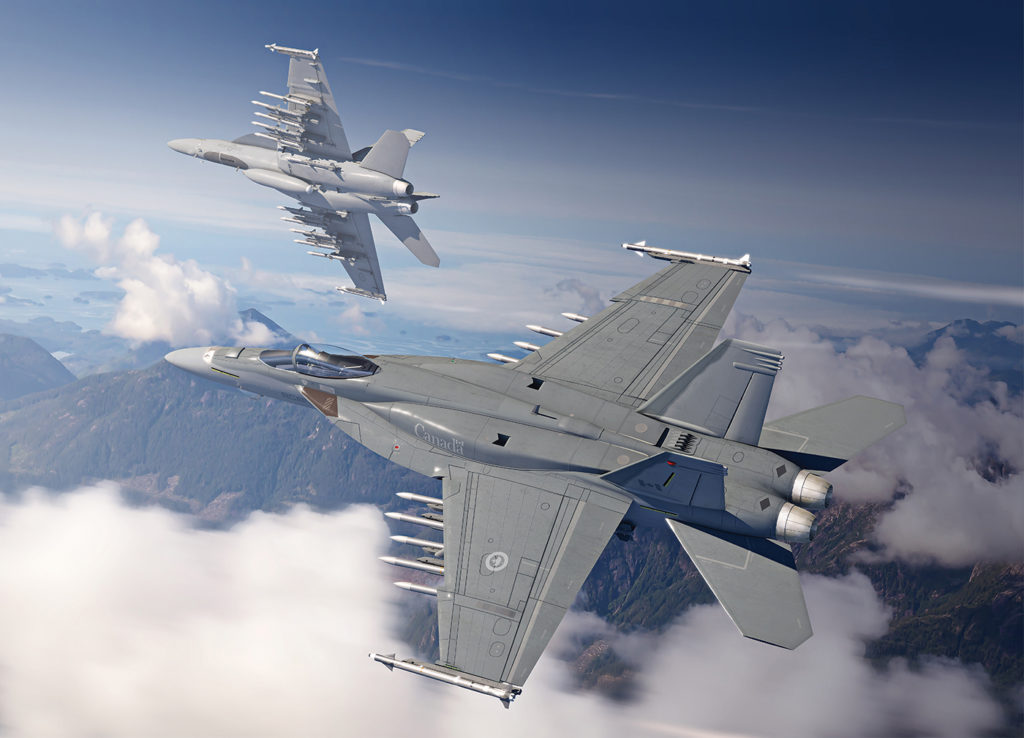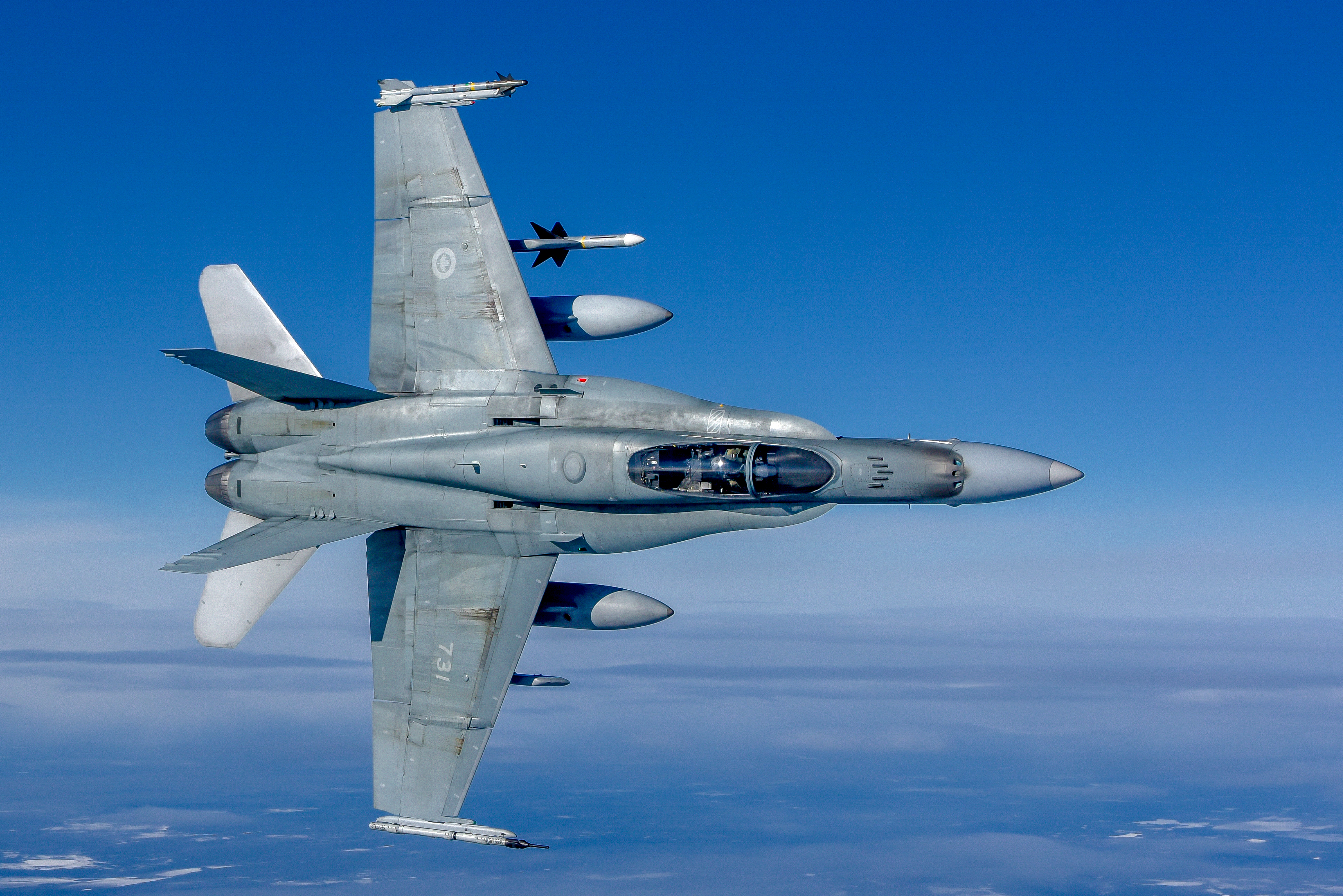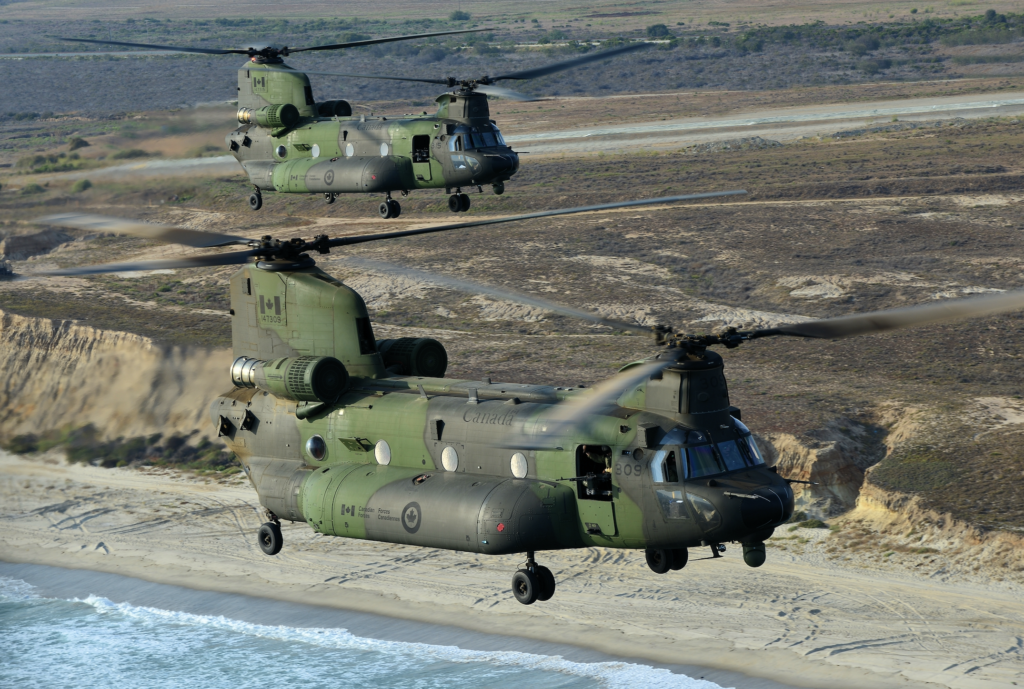Estimated reading time 7 minutes, 39 seconds.
Choosing the F/A-18E/F Super Hornet Block III to replace Canada’s aging fighter jet fleet will generate $61 billion and nearly 250,000 jobs for the Canadian economy over the 40-year life of program, according to a report by an Ottawa consulting firm.
“It means the productivity of each job is going to be around $246,000 per worker. That is very good . . . they are high-productivity jobs,” said Rick Clayton, economist at Doyletech Corp.

The astounding numbers were unveiled in a media briefing on Oct. 27 as Boeing laid out some details of its value proposition to the Canadian government and new partnership agreements with a team of Canadian companies that will sustain the aircraft if selected.
Charles “Duff” Sullivan, managing director of Boeing Canada and a former CF-188 Hornet pilot, said the consulting firm’s projections were “based on real data and direct contributions to Canada and our economy,” and are numbers the company “can guarantee to Canada.”
Boeing was one of three aircraft manufacturers to submit a bid on July 31 for 88 fighter jets to replace the Royal Canadian Air Force’s fleet of legacy CF-188 Hornets. Lockheed Martin’s F-35A Lightning II and Saab’s Gripen E are also in the running.
With up to 20 per cent of the evaluation process weighted on how well the companies meet the government’s Industrial and Technological Benefits (ITB) policy, Boeing has been keen to demonstrate the level and range of its investments across Canada.
In a similar presentation in June, Doyletech asserted that Boeing directly invested $2.3 billion in Canada in 2019, primarily through its aerospace composite manufacturing operation in Winnipeg, and generated about 11,000 jobs. Once indirect spending was factored in, those figures climbed to around $5.3 billion and 20,000 jobs.
“Those are good results,” said Clayton, noting that Boeing’s total spend in Canada has increased from approximately $1 billion to $2.3 billion annually over the last 10 years, procuring from a wide-ranging supply chain of small and medium businesses. “We have identified from our research more than 500 different suppliers.”
He emphasized that Boeing fits the definition of an “agile producer” that “maximizes local skills, industrial clusters, and supplies and inputs that are available from the local area.” Moreover, Boeing and its partners all export most of their Canadian production.

Clayton suggested all levels of government and all regions stand to benefit from the Super Hornet Block III program. Municipal governments could see as much as $994.1 million in revenue over the life of the program, while provincial and federal governments could gain $6,761.5 million and $8,487.9 million, respectively.
Over the past 25 years, Boeing has fulfilled over $11 billion in ITB obligations for programs ranging from the legacy CF-188 and an upgrade project, to the CC-177 Globemaster II, the CH-147F Chinook and the ScanEagle unmanned aerial system. Clayton called Boeing’s approach “economically efficient.”
He noted the company and its partners have large investments in every region of Canada and are “key players” in aerospace industrial clusters, which often generate high productivity indirect jobs. “It means [there are] opportunities to do vertical and horizontal linkages with Canadian suppliers and thereby multiple things.”
In particular, he flagged Boeing’s investments and direct participation in industry-university networks, centres of excellence, and even a learning factory incorporating big data, machine learning and artificial intelligence. “In fact, we think that Boeing’s commitment to innovation alone has a benefit of almost $4 billion. It is one of the most important parts of the Boeing proposition.”
Jennifer Seidman, Boeing’s lead for international strategic partnerships in Canada, confirmed the company’s commitment to “deliver 100 per cent” of its ITB obligations. She noted that Boeing’s offer “exceeds the minimum requirements for in-country support in training, maintenance support – both aircraft and engines – weapons systems management and engineering, and information and material management.”
As part of Boeing’s previous ITB commitments, she highlighted several recent investments in Canadian companies, including a cash investment and engineering support in Bluedrop Training & Simulation to develop a full size, high fidelity and immersive virtual reality ramp trainer for the V-22 Osprey. As well as investments in Heroux-Devtek for the main landing gear for the F-18 Hornet program, and nose and main landing gear for the F-15 Eagle program.
Boeing has said previously it will sustain the Super Hornet using a model developed to support the CH-147F Chinook program at 450 Tactical Helicopter Squadron in Petawawa, Ont. The benefits of that “tip-to-tail” model became evident during the Chinook’s 12-month aeromedical evacuation mission on Operation Presence in Mali in 2018-19, said Mario Clement, who leads Boeing’s sustainment program in Canada.

That program relies on support from several partners, some of whom will help sustain the Block III Super Hornet. As part of the media briefing, Boeing announced five new agreements with CAE, L3Harris Technologies, Peraton Canada, Raytheon Canada and GE Canada Aviation that will ensure training solutions; sustainment services; avionics repair and overhaul; supply chain and warehousing services; and maintenance, repair and overhaul support services for the F414 engines, respectively.
Boeing evaluated the merits of building the Super Hornet in Canada, but saw little long-term benefit with a relatively small production run of 88 aircraft, said Jim Barnes, director of business development in Canada for Boeing Defense, Space & Security. “It didn’t make business sense to us, so our offering is concentrating on decades and decades of lifecycle.”
Final assembly will occur in St. Louis, Mo., and the intellectual property and knowledge of the Block III will be transferred to its partners following a “build-in” approach similar to the legacy fleet, where more is shared “as our Canadian partners accept more and more work on the platform.”









As a commercial crime fraud investigator of over 40 years .. I learned early that .. If it’s too crazy to believe then It’s more than likely too crazy to believe. Why would the Canadian Government and no others, (by the way, no other NATO county likely will be purchasing the Super Hornet in the future), be silly enough to be the only purchaser of the current bottom of the heap 4th Gen fighter jet, all others considered, F-16, F -15, Euro-fighter etc and which has to remain technologically relevant for the next 30 years from a highly US Gov subsidized partner supplier, of questionable reliability who “attacked Canadian industry” (Bombardier C-Series), who intends, from all reports, on shutting down the Super Hornet production line and logically thinking as well, the support and parts supply chain around 2030? Why would Boeing keep the parts and support supply chain efficiently operating for the sale of 88 planes for one country over the next 30 years? It would be like selling Canada the most advanced F-86 Sabres in 1958 with the promise of a 30 year support supply chain into the 1980’s. It makes absolutely no sense. To the point of being ridiculous. As Shakespeare wrote in Hamlet.. “The lady doth protest too much, methinks” .. Well.. Methinks someone wishes to sell a plane too much.
Butch regarding your comment about the CF18 Super Hornet, the block 111 version is a 4+ Gen. jet.
The expensive F35 physical qualities is going to be less stealthy with future radar advances and only advances in electronic counter measures will be able to help this fighter get past future Area Access Denial measures. So with soft wear upgrades and new electronics the Super Hornet is able to keep up to date in air warfare requirements during the projected 40 years. The advantages of stealthy features are likely going to fade over time as AAD measures improve.
I think too the F18 would be a better choice with it’s twin engines and is more likely to return to base over a single engine jet like the F35 or Gripen E. In Canada’s vast North this is an important consideration to a pilot. The payload capacity of the F18 is far better too over the other two single engine competitors making it a better multi-role fighter.
Saab Gripen E designers prefer not to focus on physical stealth features (other than it’s small size which gives it a smaller radar cross section) but rather on electronic counter measures. This makes a lot of sense, as it is easier and faster to adjust to future requirements by changing the software and electronic components, or weapon systems compared to changing the physical stealthy properties of a jet which become outdated quickly. Good linkage with a complete battle system is what gives a future jet it’s biggest advantage and the block 111 offers great potential as does the F35 and the Gripen E.
Boeing is a company with no scruples whatsover. This is not incremental money, its money they will spend already to support their existing business here. Canada should go with a fleet of SAAB Gripens, its likely whatever we buy will be obsolete quite fast due to the development of drones. Gripens and Global EYE MPAs, hopefully built in Canada. Boeing cannot offer this.
When Boeing imposed the 292% duty on Bombardier is when Canadians decided to go with Saab. Saab is a better plane with better people.
If Canada bought the Gripen it would show the US that it needs to take Canada Seriously when offering their equipment for sale and not bully them
The Gripen would make a Great Purchase
True
International relations aside, the only plane of the three being considered that makes good economic and operational sense is the Saab Gripen E. The Super Hornet is at the end of it’s global market life and the F35 is an overpriced (albeit attractive) turkey. If we absolutely must buy American the Super Hornet III is a logical continuation for the Canadian forces.
Canada should buy 15 E18 growlers and the rest should be F15 EX Strike Eagles
VP Harris will instruct Justin on best course of action.
The Canadian Government and military needs to tell BOEING to shove the Hornet up their Bombardier!
250,000 jobs associated with the production and in service support of 88 fighters? Not a chance. I’d like to know what they define as a distinct job. How many actual person years of work? How far downstream are these jobs?
If the numbers are even remotely realistic, then we could expect similar benefits from the other bidders. So why would this be a benefit unique to Boeing?